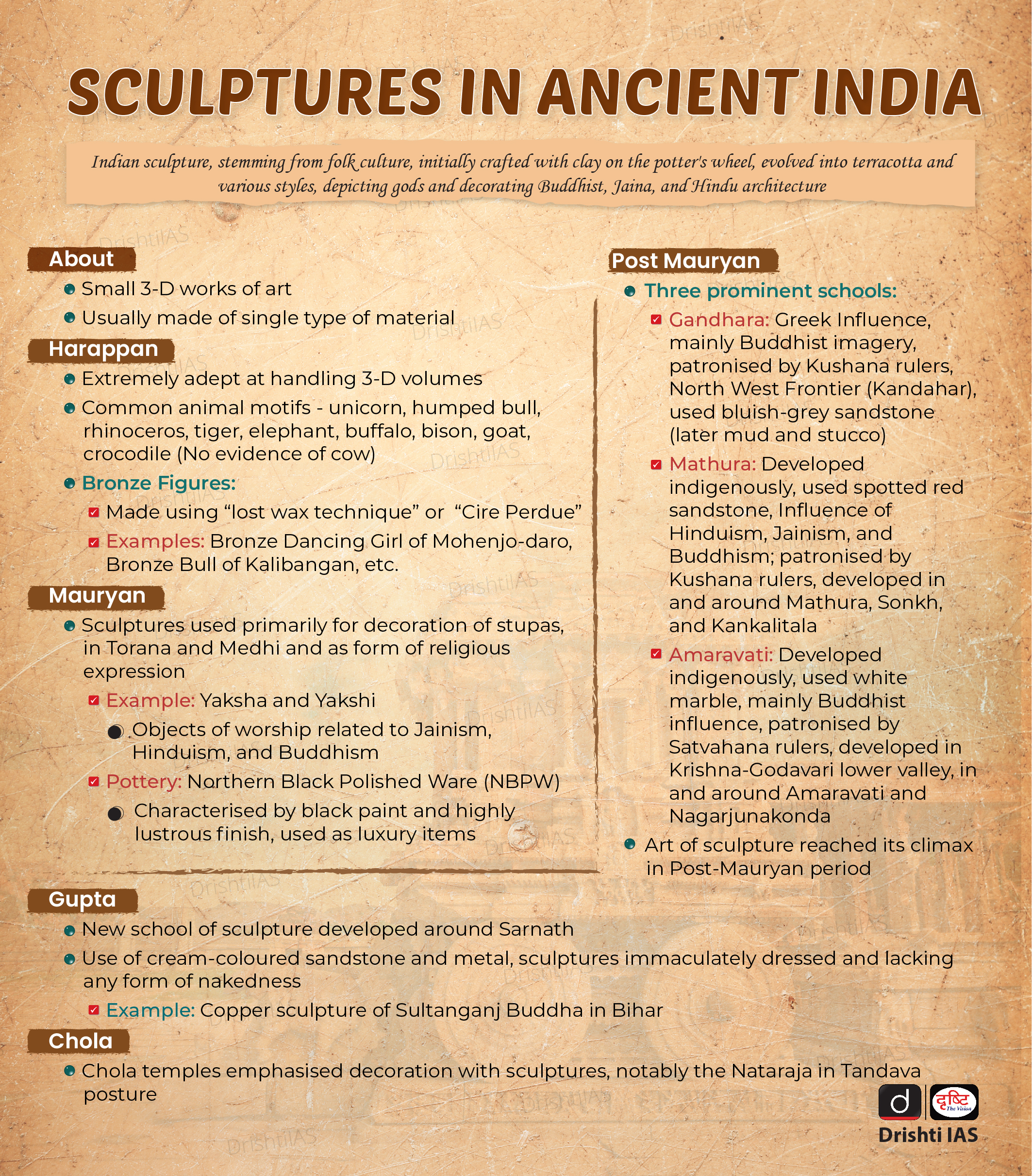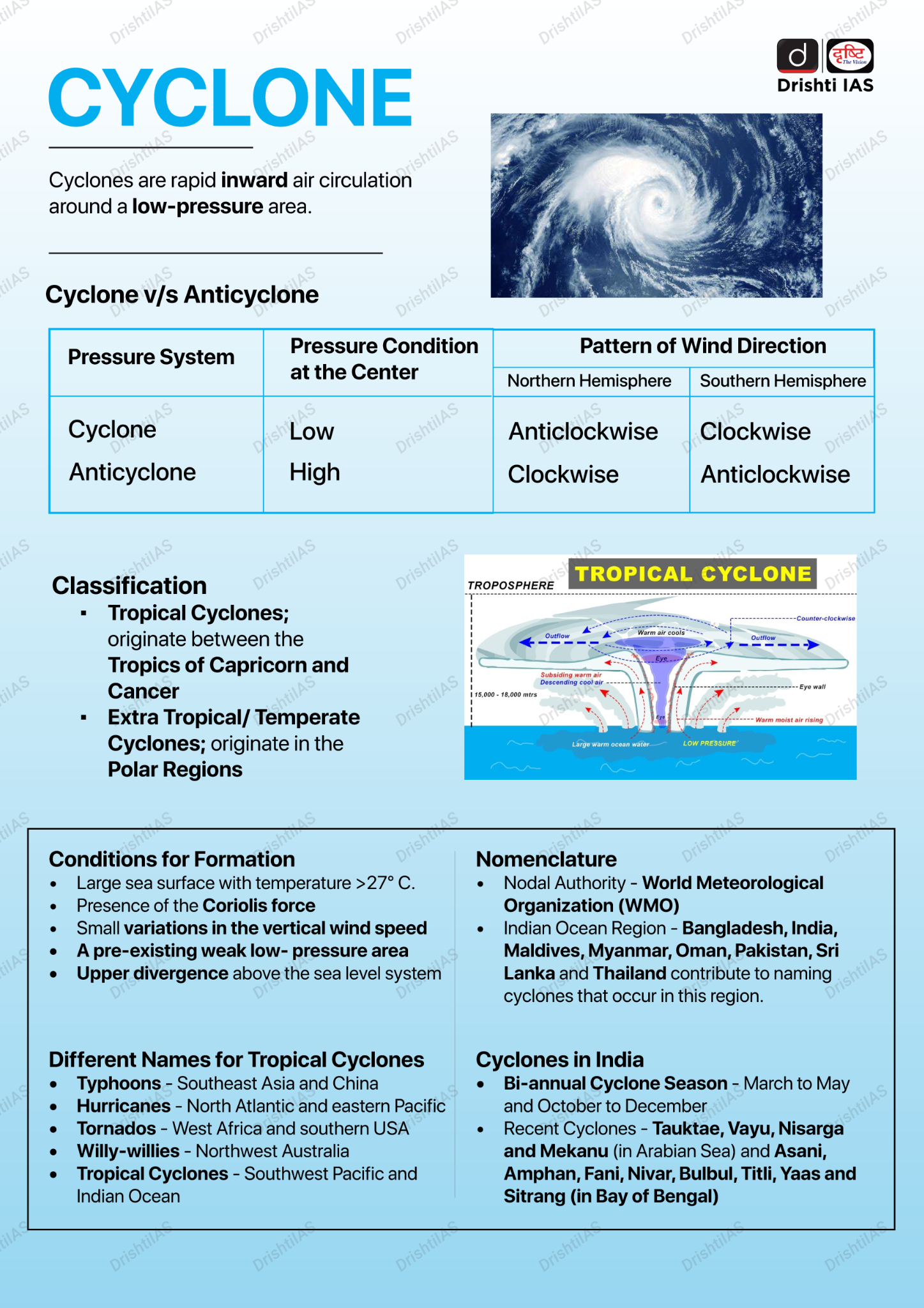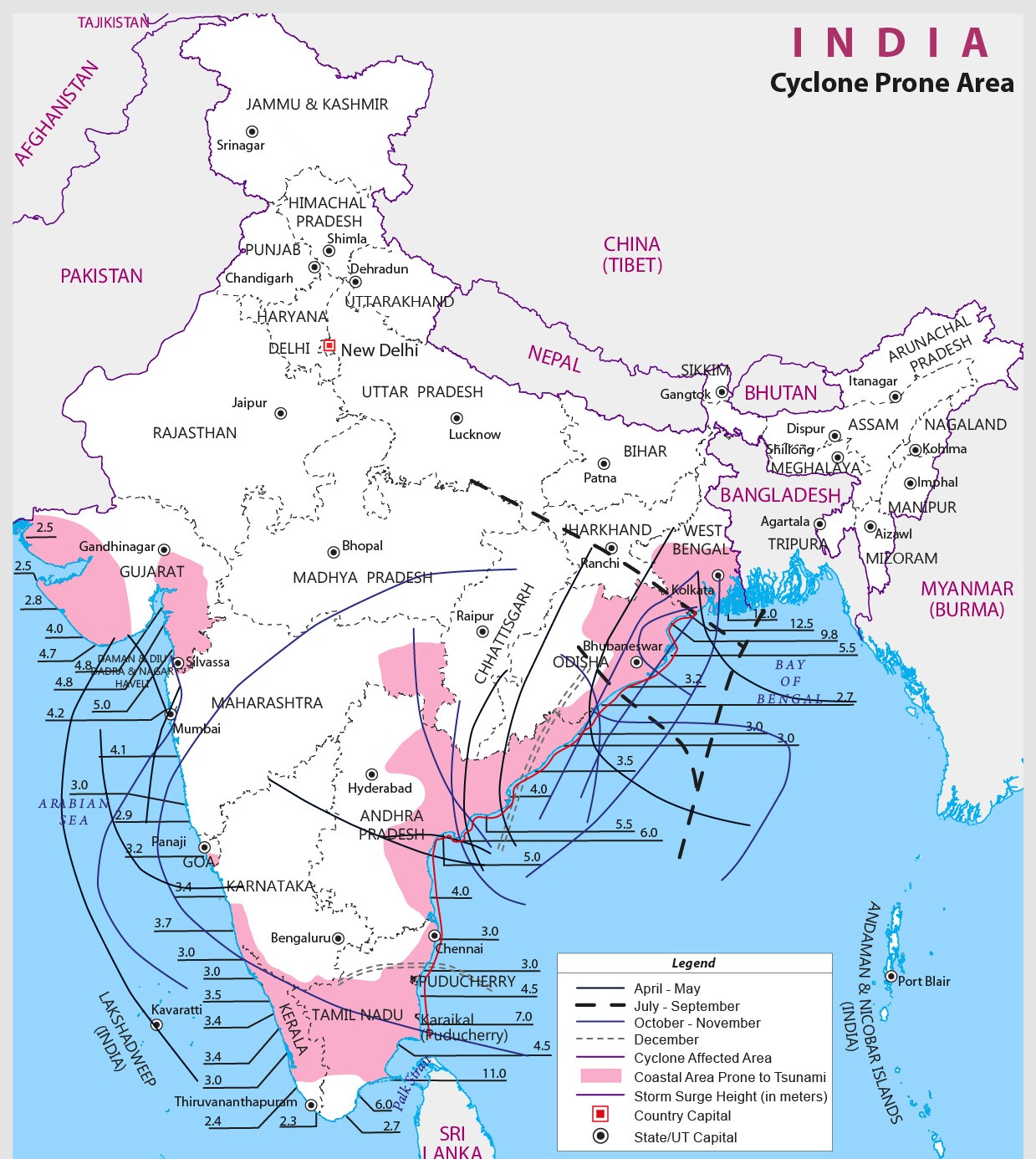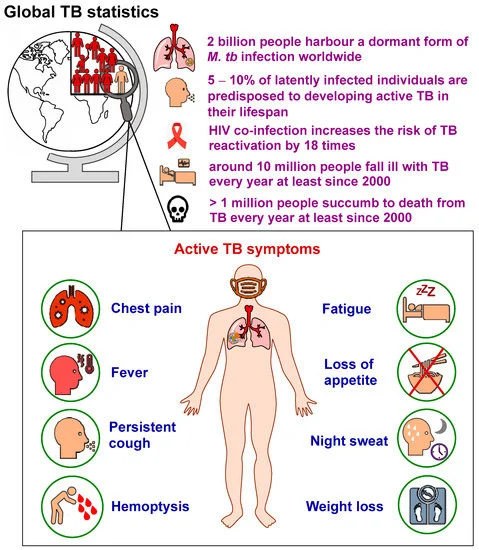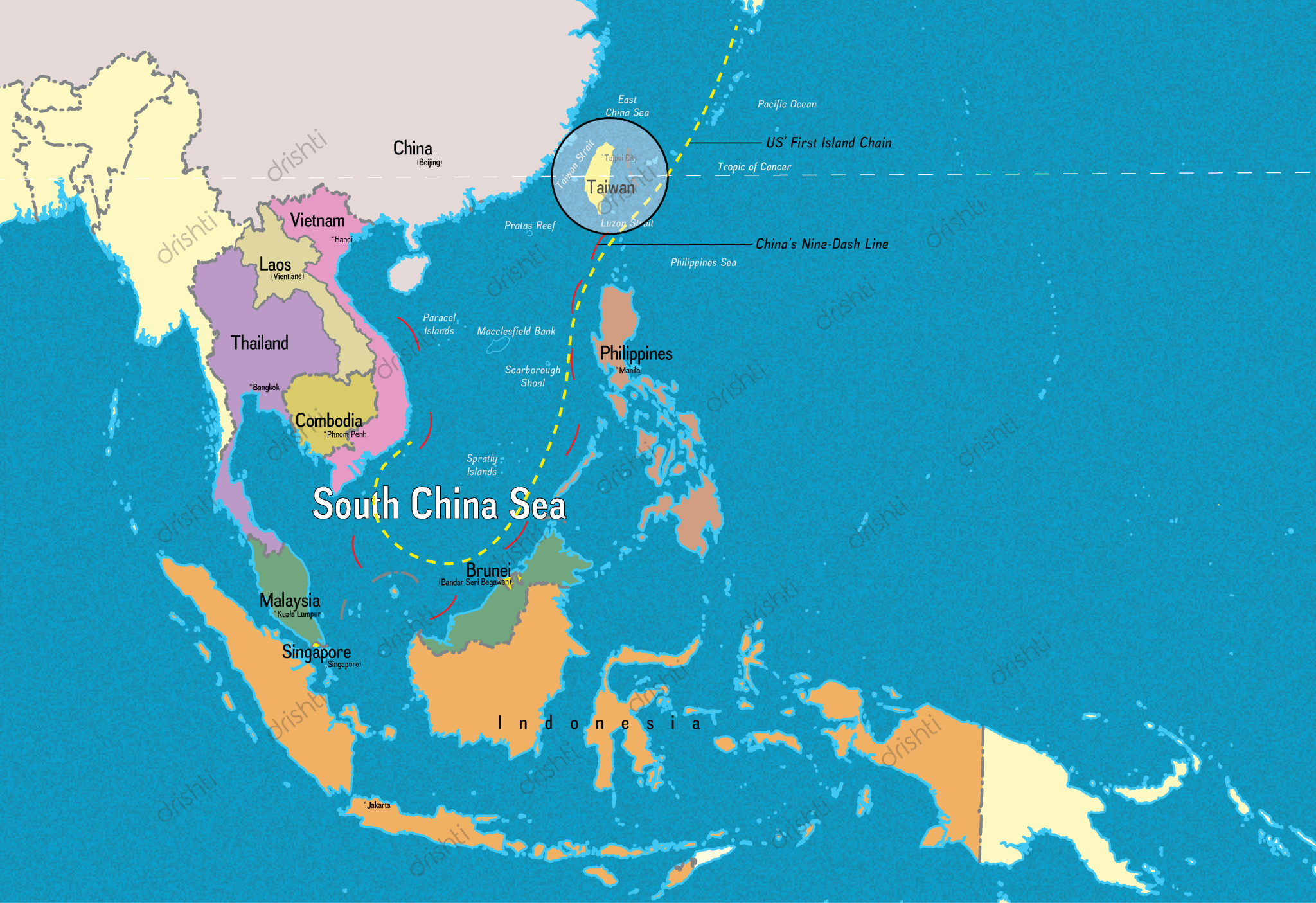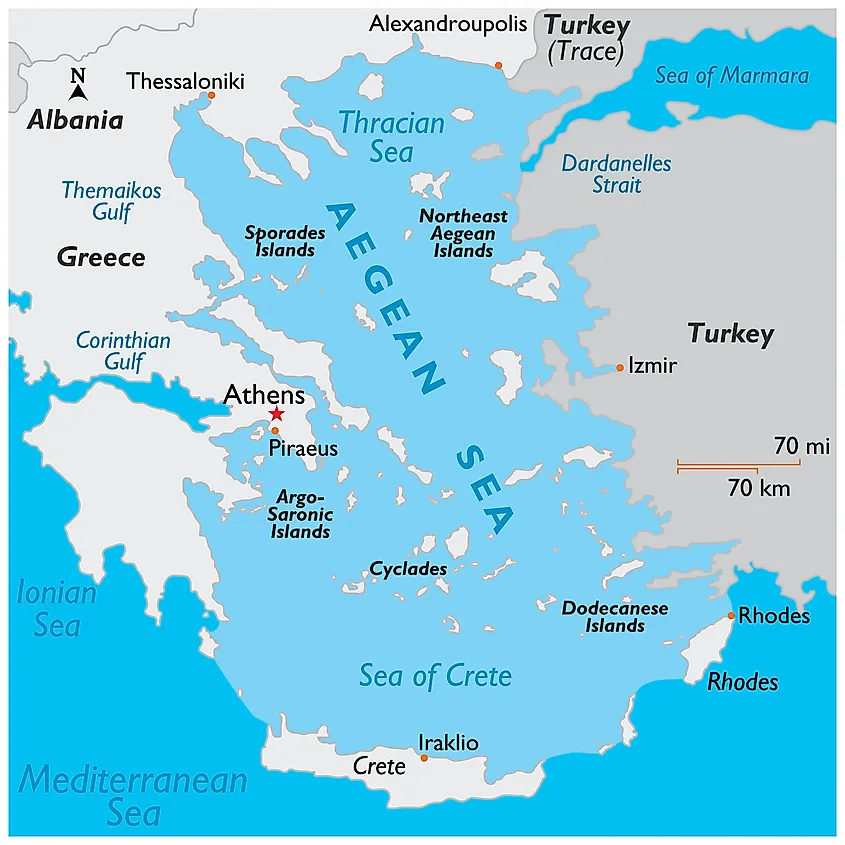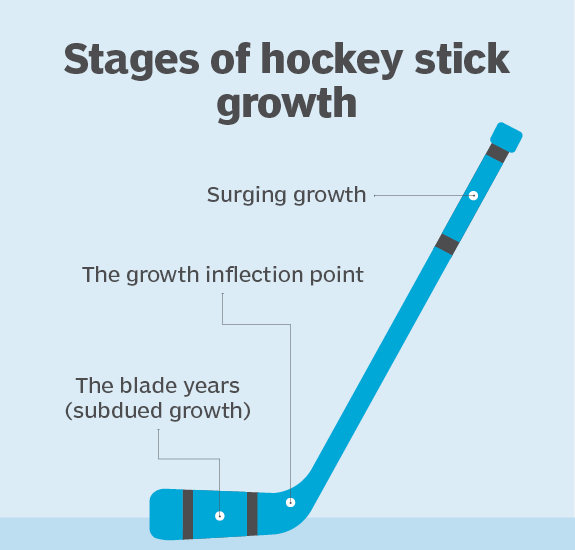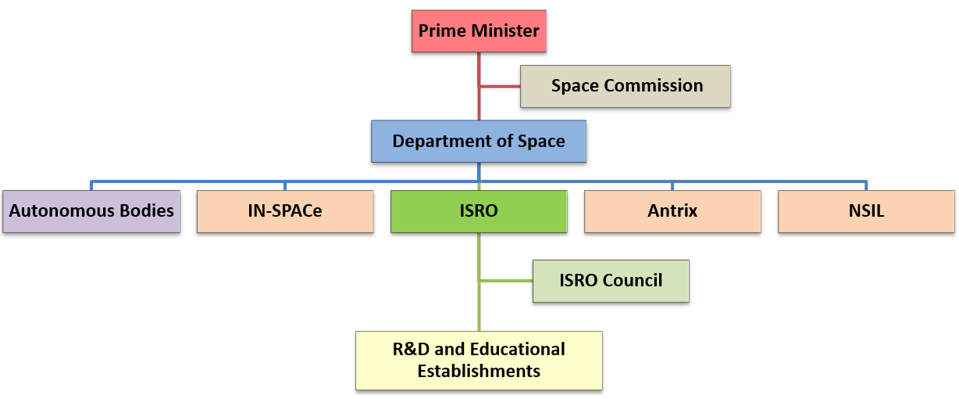Infographics
Geography
Tropical Cyclones Need New Category
For Prelims: Tropical Cyclones Need New Category, Tropical Cyclones, Hurricanes, Saffir-Simpson (SS) Scale, Global Warming.
For Mains: Tropical Cyclones Need New Category, Important Geophysical phenomena such as earthquakes.
Why in News?
Recently, a study has been published in the journal Proceedings of National Academy of Sciences, where researchers have claimed that wind speed during a hurricane can cross 309 km/hour and therefore wind scale must add a Category 6.
What are the Key Highlights of the Study?
- Reconsideration of Saffir-Simpson (SS) Scale:
- There are concerns about the adequacy of the Saffir-Simpson (SS) Hurricane Wind Scale, which has been used for over 50 years to communicate hurricane risk based solely on wind speed.
- There are five categories on the SS hurricane wind scale — category 1 to category 5 — with category 5 wind speed exceeding 252 km/hour.
- The combined effects of wind, storm surge, and rainfall in a category 5 impact would completely raze any structure.
- There are five categories on the SS hurricane wind scale — category 1 to category 5 — with category 5 wind speed exceeding 252 km/hour.
- The open-ended Category 5 may no longer be sufficient to communicate the increasing risk of hurricane damage in a warming climate.

- There are concerns about the adequacy of the Saffir-Simpson (SS) Hurricane Wind Scale, which has been used for over 50 years to communicate hurricane risk based solely on wind speed.
- Introduction of Hypothetical Category 6:
- Due to Global Warming, there is now a need to define a category 6 cyclone.
- The warming can be observed not only at the sea surface, but also in the depths of the ocean, which increases the heat content of the ocean and thus favours the intensification of tropical cyclones.
- To address the limitations of the existing scale the introduction of a hypothetical Category 6 to the Saffir-Simpson Wind Scale is proposed with the wind speed above 309 km/hour.
- Due to Global Warming, there is now a need to define a category 6 cyclone.
- Impact of Global Warming on Hurricane Intensification:
- Increased greenhouse gas emissions have caused the Earth to warm by about 1.10 degrees Celsius since pre-industrial times and caused more intense tropical cyclones in the oceans.
- For every degree of warming, the strongest cyclones are getting 12% stronger, making them 40% more destructive.
- As the oceans warm, cyclones also strengthen faster and spend more lifetime over the oceans.
- In 2023, tropical cyclone Freddy spent 37 days over the oceans, making it the longest-lived cyclones ever recorded.
- Increased greenhouse gas emissions have caused the Earth to warm by about 1.10 degrees Celsius since pre-industrial times and caused more intense tropical cyclones in the oceans.
- Implications for Risk Messaging:
- The findings underscore the importance of revising risk messaging to better inform the public about the increased risk of major hurricanes due to global warming.
- SS Scale does not address issues related to inland flooding and storm surge, which are also critical components of hurricane risk.
- Therefore, changes in messaging beyond wind-based scales are necessary to adequately communicate the full spectrum of hurricane hazards.
Note:
- Once a tropical cyclone reaches maximum sustained winds of 119 km/hour or higher, it is then classified as a hurricane, typhoon, or tropical cyclone, depending upon where the storm originates in the world.
- In the North Atlantic, central North Pacific, and eastern North Pacific, the term hurricane is used.
- The Western Pacific basin is the most active region for tropical cyclones and accounts for about a third of the world’s tropical cyclones.
- The North Indian basin accounts for only about 4% of the global total, although it is one of the most vulnerable regions in the world to the effects of such cyclones.
What are Cyclones?
|
Drishti Mains Question: Q: Examine the limitations of the current Saffir-Simpson (SS) Scale and elucidate how the introduction of Category 6 can address these limitations. |
UPSC Civil Services Examination Previous Year Question (PYQ)
Prelims
Q. Consider the following statements: (2020)
- Jet streams occur in the Northern Hemisphere only.
- Only some cyclones develop an eye.
- The temperature inside the eye of a cyclone is nearly 10ºC lesser than that of the surroundings.
Which of the statements given above is/are correct?
(a) 1 only
(b) 2 and 3 only
(c) 2 only
(d) 1 and 3 only
Ans: (c)
Q. In the South Atlantic and South-Eastern Pacific regions in tropical latitudes, cyclone does not originate. What is the reason? (2015)
(a) Sea surface temperatures are low
(b) Inter-Tropical Convergence Zone seldom occurs
(c) Coriolis force is too weak
(d) Absence of land in those regions
Ans: (b)
Mains:
Q. Tropical cyclones are largely confined to the South China Sea, Bay of Bengal and Gulf of Mexico. Why? (2014)
Social Justice
India TB Report 2024
For Prelims: India TB Report 2024, Tuberculosis (TB), Undernourishment, HIV, Diabetes, Multi-Drug Resistant TB.
For Mains: India TB Report 2024, Challenges to Eliminating TB, India’s Progress in Eliminating TB.
Why in News?
Recently, the Ministry of Health and Family Welfare released the India TB Report 2024, which highlights that the mortality rate due to Tuberculosis (TB) had declined from 28 per lakh population in 2015 to 23 per lakh population in 2022.
What are the Key Highlights of the Report?
- Trends in TB Cases and Deaths:
- The majority of the TB cases are still reported by the government health centres, even as there has been an uptick in notifications by the private sector.
- Nearly 33% or 8.4 lakh of the 25.5 lakh cases reported in 2023 came from the private sector.
- To compare, only 1.9 lakh cases were reported by the private sector in 2015, the year considered to be the baseline by the programme that is geared towards the elimination of the disease.
- The estimated incidence of TB in 2023 increased slightly to 27.8 lakh from the previous year’s estimate of 27.4 lakh.
- The mortality due to the infection remained the same at 3.2 lakh.
- India’s TB mortality dropped from 4.94 lakhs in 2021 to 3.31 lakhs in 2022.
- India reached its 2023 target of initiating treatment in 95% of patients diagnosed with the infection.
- The majority of the TB cases are still reported by the government health centres, even as there has been an uptick in notifications by the private sector.
- Challenges in Meeting Targets:
- Despite setting ambitious goals to eliminate tuberculosis by 2025, India has faced challenges in meeting these targets.
- The number of cases and deaths recorded in 2023 fell short of the targets set by the country.
- There are various risk factors that contribute to the incidence and treatment outcomes of tuberculosis.
- These include Undernourishment, HIV, Diabetes, Alcohol Use, and smoking.
- Undernourishment:
- Nearly 7.44 lakh TB patients were undernourished in 2022. To improve nutrition, the government provides monthly support of Rs 500 to nearly one crore beneficiaries.
- Other than that, the Ni-kshay Mitra programme calls for the donation of food baskets.
- Nearly 7.44 lakh TB patients were undernourished in 2022. To improve nutrition, the government provides monthly support of Rs 500 to nearly one crore beneficiaries.
- HIV:
- People living with HIV have a 20-times higher risk of developing symptoms of TB as compared to the normal population. Altogether 94,000 TB patients in 2022 had HIV.
- Diabetes:
- Of the 3.70 lakh TB patients with diabetes globally in 2022, 1.02 lakh were in India as per estimates.
- Diabetes escalates the likelihood of contracting TB two-to-threefold, which in turn is linked to increased risk of Multi-Drug Resistant TB.
- The TB treatment also does not work as well in diabetics. Nearly 92% of TB patients were screened for diabetes in 2023, with 7.7% being diagnosed with it. And, nearly 63% of those diagnosed initiated diabetes treatment as per the report.
- Alcohol and Tobacco Use:
- A daily intake of more than 50 ml of alcohol increases the risk of TB infection, active infection and recurrence of infection.
- Around 18.8 lakh or 74% of TB patients underwent alcohol use screening, out of which 7.1% were identified as alcohol users.
- In 2023, around 19.1 lakh or 75% of TB patients were screened for tobacco use, of whom 11% were identified as tobacco users.
- And 32% of these people were linked to tobacco cessation services.
- A daily intake of more than 50 ml of alcohol increases the risk of TB infection, active infection and recurrence of infection.
What is Tuberculosis?
- About:
- Tuberculosis is a bacterial infection caused by Mycobacterium tuberculosis. It can practically affect any organ of the body. The most common ones are the lungs, pleura (lining around the lungs), lymph nodes, intestines, spine, and brain.
- Transmission:
- It is an airborne infection that spreads through close contact with the infected, especially in densely populated spaces with poor ventilation.
- Symptoms:
- Common symptoms of active lung TB are cough with sputum and blood at times, chest pains, weakness, weight loss, fever and night sweats.
- Infection Prevalence:
- Every year, 10 million people fall ill with TB. Despite being a preventable and curable disease, 1.5 million people die from TB each year – making it the world’s top infectious killer.
- TB is the leading cause of death of people with HIV and also a major contributor to antimicrobial resistance.
- Most of the people who fall ill with TB live in low- and middle-income countries, but TB is present all over the world. About half of all people with TB can be found in 8 countries: Bangladesh, China, India, Indonesia, Nigeria, Pakistan, Philippines and South Africa.
- Treatment:
- TB is treated with a standard 6-month course of 4 antimicrobial drugs that are provided with information, supervision and support to the patient by a health worker or trained volunteer.
- Anti-TB medicines have been used for decades and strains that are resistant to 1 or more of the medicines have been documented in every country surveyed.
- Multidrug-resistant Tuberculosis (MDR-TB) is a form of TB caused by bacteria that do not respond to isoniazid and rifampicin, the 2 most powerful, first-line anti-TB drugs.
- MDR-TB is treatable and curable by using second-line drugs such as bedaquiline.
- Extensively drug-resistant TB (XDR-TB) is a more serious form of MDR-TB caused by bacteria that do not respond to the most effective second-line anti-TB drugs, often leaving patients without any further treatment options.
- Multidrug-resistant Tuberculosis (MDR-TB) is a form of TB caused by bacteria that do not respond to isoniazid and rifampicin, the 2 most powerful, first-line anti-TB drugs.
- Drugs for TB:
- Isoniazid (INH): This drug is a cornerstone of TB treatment and is highly effective against Mycobacterium tuberculosis.
- It works by inhibiting the synthesis of mycolic acids in the bacterial cell wall.
- Rifampicin (RIF): Another essential drug in TB treatment, rifampicin works by inhibiting the synthesis of RNA in the bacteria.
- It is often used in combination with other drugs to treat TB and is crucial for preventing the development of drug resistance.
- Delamanid: Delamanid is a newer drug that is used in the treatment of multidrug-resistant TB (MDR-TB) and is often used in combination with other drugs.
- Isoniazid (INH): This drug is a cornerstone of TB treatment and is highly effective against Mycobacterium tuberculosis.
What are Different Initiatives to Combat TB?
- Global Efforts:
- The WHO (World Health Organisation) has launched a joint initiative “Find. Treat. All. #EndTB” with the Global Fund and Stop TB Partnership.
- WHO also releases the Global Tuberculosis Report.
- The Global Plan to End TB, 2023-2030: It is a plan for ending TB as a public health challenge by 2030. It provides a blueprint of priority actions required and a detailed estimate of the financial resources needed to end TB.
- It is a goal that has been adopted by all Member States of the United Nations (UN) and the WHO.
- The End TB Strategy builds on and significantly expands the scope of efforts in the context of the United Nations Sustainable Development Goal 3.3.
- The WHO (World Health Organisation) has launched a joint initiative “Find. Treat. All. #EndTB” with the Global Fund and Stop TB Partnership.
- India’s Efforts:
- Pradhan Mantri TB Mukt Bharat Abhiyan
- National Strategic Plan (NSP) for Tuberculosis Elimination (2017-2025)
- TB Harega Desh Jeetega Campaign
- Nikshay Poshan Yojna
- RePORT India: RePORT India (Regional Prospective Observational Research for Tuberculosis (TB)) is a bilateral, multi-organizational, collaborative effort established in 2013 under the Indo-US Vaccine Action Program (VAP).
- It aims to address the threat of TB to the people of India and across the globe.
Conclusion
- The path to TB elimination in India requires a concerted effort to prioritise person-centred care, address social determinants of health, and embrace innovation. By adopting a holistic and person-centred approach, India can overcome the barriers that stand in the way of TB control and create a healthier future for all its citizens.
|
Drishti Mains Question: Q: Analyse the challenges hindering the progress towards eliminating TB in India. In light of the identified challenges propose strategies to overcome the barriers to achieving TB elimination. |
UPSC Civil Services Examination, Previous Year Questions (PYQs)
Prelims
Q. Which of the following are the objectives of ‘National Nutrition Mission’? (2017)
- To create awareness relating to malnutrition among pregnant women and lactating mothers.
- To reduce the incidence of anaemia among young children, adolescent girls and women.
- To promote the consumption of millets, coarse cereals and unpolished rice.
- To promote the consumption of poultry eggs.
Select the correct answer using the code given below:
(a) 1 and 2 only
(b) 1, 2 and 3 only
(c) 1, 2 and 4 only
(d) 3 and 4 only
Ans: (a)
Mains
Q. “Besides being a moral imperative of a Welfare State, primary health structure is a necessary precondition for sustainable development.” Analyse. (2021)
Governance
Internet Freedom
For Prelims: Citizenship Amendment Act, 2019, Article 370, 2019, Section 144 of the Code of Criminal Procedure.
For Mains: Internet Freedom, E-governance- applications, models, successes, limitations, and potential, Transparency and accountability.
Why in News?
For five straight years, India has topped the global list of countries imposing internet bans, with about 60% of all blackouts recorded in the world, between 2016 and 2022 having been in India.
- State imposed shutdowns in the last decade have cited national security and threats to public order. However, rights groups have argued that these shutdowns also violate court directives.
What are the Key Trends of Internet Shutdown in India?
- Instances of Internet Shutdown:
- The Indian government imposed a total of 780 shutdowns between 1stJanuary, 2014, and 31st December, 2023, according to data collected by the Software Freedom Law Centre (SFLC).
- Shutdowns flared up during the protests against the Citizenship Amendment Act in 2019, the abrogation of Article 370 in 2019, and the introduction of Farm Bills in 2020.
- Internet disruptions in India accounted for more than 70% of the total loss to the global economy in 2020.
- India shut down the internet for over 7,000 hours in 2023.
- Regionally, Jammu and Kashmir saw the highest number of shutdowns — at 433 — in the last 12 years.
- The longest blackout in 2023 took place in Manipur from May to December, amid ethnic clashes.
- Regionally, Jammu and Kashmir saw the highest number of shutdowns — at 433 — in the last 12 years.
- Between 2015 and 2022, more than 55,000 websites were blocked, according to SFLC data.
- The biggest share of content censored was done under section 69A of the IT Act, by the Ministry of Electronics and Information Technology and the Ministry of Information and Broadcasting.
- URLs were blocked due to links to organizations banned under the Unlawful Activities (Prevention) Act.
- Global Internet Freedom:
- Global Internet freedom has declined for the 13th consecutive year, and the environment for human rights online has deteriorated in 29 countries, according to the latest Freedom House report.
- India’s ranking has hovered around the same benchmark in the last three years.
- This is a dip from 2016 and 2017, when India scored 59 points, to 50 points in 2023.
- Global Internet freedom has declined for the 13th consecutive year, and the environment for human rights online has deteriorated in 29 countries, according to the latest Freedom House report.
What are the Provisions Related to Internet Shutdown?
- Section 5(2) of the Indian Telegraph Act, 1885, read with Temporary Suspension of Telecom Services (Public Emergency and Public Safety) Rules, 2017:
- These rules allow the union or state home secretary to order the suspension of any telegraph service (including internet) in case of public emergency or public safety.
- Such an order must be reviewed by a committee within five days and cannot last for more than 15 days. In an urgent situation, an officer of joint secretary level or above, authorized by the union or state home secretary, can issue the order.
- However, the law does not define what qualifies as an emergency or safety issue. The Supreme Court, in the landmark Anuradha Bhasin v. Union of India case, 2020 reiterated that internet shutdowns violate fundamental rights to freedom of expression and shutdowns lasting indefinitely are unconstitutional.
- Section 144 of the Code of Criminal Procedure:
- This section empowers a district magistrate, a sub-divisional magistrate or any other executive magistrate specially empowered by the state government to issue orders to prevent or stop any nuisance or disturbance of public tranquility.
- Such orders can include the suspension of internet services in a particular area for a specified period.
What are the Arguments Regarding Internet Shutdown?
- Prevents Hate Speech and Misinformation:
- Internet shutdowns can help to prevent the spread of hate speech and fake news that could incite violence and riots.
- For example, the government announced the internet shutdown in Delhi NCR following the farmers’ protest on Republic Day to combat misinformation and maintain law and order.
- Prevents any Anti-National Activities:
- Internet shutdowns can help curb the organization and mobilization of protests that could disrupt public order and security.
- For example, the government imposed internet shutdowns in Kashmir and other parts of the country after the abrogation of Article 370 to prevent any anti-national activities and separatist movements.
- Protects National Security:
- Internet shutdowns can help protect national security and sovereignty from external threats and cyberattacks.
- For example, the government suspended internet services in some border areas during the standoff with China to prevent any espionage or sabotage.
- Curb on Objectionable Content from Consumption:
- Internet shutdowns can help control the distribution and consumption of content that could be harmful or offensive to certain groups or individuals.
- For example, the government blocks internet access in some regions to prevent the circulation of objectionable images or videos.
What are the Concerns Related to Internet Shutdown?
- Violation of Rights:
- Internet shutdowns violate Fundamental Rights under Article 19(1)(a) and Article 19(1)(g).
- The freedom of speech and expression and freedom to practice any profession over the medium of the internet enjoy constitutional protection under Article 19(1)(a) and Article 19(1)(g) - the Supreme Court in Anuradha Bhasin vs Union of India case (2020).
- Internet Shutdown also violates Right to Information which has been declared as a Fundamental Right under Article 19 by the Supreme Court in Raj Narain vs State of UP (1975) case.
- Internet Shutdowns also violate the Right to Internet which was declared a Fundamental Right under Article 21 by the Kerala High Court in Faheema Shirin v. State of Kerala case.
- Internet shutdowns violate Fundamental Rights under Article 19(1)(a) and Article 19(1)(g).
- Lack of Accountability:
- Shutdowns are often implemented without clear legal frameworks or oversight mechanisms, leading to arbitrary and disproportionate restrictions on internet access.
- The absence of accountability mechanisms exacerbates the risk of abuse of power by authorities, who may impose shutdowns without adequate justification or recourse for affected individuals.
- Economic Disruption:
- Beyond the immediate social and political implications, internet shutdowns have significant economic repercussions. Disruptions to online commerce, communication, and financial transactions disrupt business operations, hinder economic growth, and deter investment, ultimately undermining long-term development objectives.
- According to Top10VPN, India lost Rs 2,091 crore ($255.2 million) in the first half of 2023 because of internet shutdowns.
- Beyond the immediate social and political implications, internet shutdowns have significant economic repercussions. Disruptions to online commerce, communication, and financial transactions disrupt business operations, hinder economic growth, and deter investment, ultimately undermining long-term development objectives.
- Social Disruption:
- Shutdowns disrupt the fabric of society by impeding communication networks, hindering access to vital services, and isolating individuals from their communities. Social cohesion may suffer as a result, as people are unable to connect, organize, or mobilize effectively, leading to feelings of isolation and alienation.
Way Forward
- The Government authorities should follow the directions of the Supreme Court in the Anuradha Bhasin case (2020). The Supreme Court issued following guidelines:
- Suspension can be utilized for a temporary duration only.
- Any order suspending the internet issued under the Suspension Rules must adhere to the principle of proportionality and must not extend beyond the necessary duration.
- Any order suspending the internet under the Suspension Rules is subject to judicial review.
- Strengthening the legal and regulatory framework that governs internet shutdowns, and ensuring that they are only used as a last resort, in accordance with international human rights standards.
- The government should amend the Telegraph Act and its rules, which are outdated and vague, and do not comply with constitutional and human rights standards.
- The government should consider other less intrusive measures to deal with law-and-order disturbances, communal violence, terrorist attacks, examinations, and political instability, such as blocking specific websites or content, issuing warnings or advisories, engaging with civil society and media, or deploying more security forces.
|
Drishti Mains Question: Q: Evaluate the constitutional and human rights concerns associated with these shutdowns and suggest measures to address them in line with international standards |
UPSC Civil Services Examination, Previous Year Questions (PYQs)
Prelims
Q. Right to Privacy is protected as an intrinsic part of Right to Life and Personal Liberty. Which of the following in the Constitution of India correctly and appropriately imply the above statement? (2018)
(a) Article 14 and the provisions under the 42nd Amendment to the Constitution.
(b) Article 17 and the Directive Principles of State Policy in Part IV.
(c) Article 21 and the freedoms guaranteed in Part III.
(d) Article 24 and the provisions under the 44th Amendment to the Constitution.
Ans: (c)
Mains:
Q. What do you understand by the concept of “freedom of speech and expression”? Does it cover hate speech also? Why do the films in India stand on a slightly different plane from other forms of expression? Discuss. (2014)
International Relations
India Stands with the Philippines in the South China Sea
For Prelims: Philippines, South China Sea, Taiwan, Luzon Strait, Malacca Strait, Nine-dash line, Senkaku Islands, Aegean Sea, Exclusive Economic Zones, Act East Policy, ASEAN, BrahMos supersonic cruise missile.
For Mains: Dispute in the South China Sea Region, Areas of Cooperation Between India and Philippines.
Why in News?
India's Ministry of External Affairs recently expressed firm support for the Philippines in defending its national sovereignty amidst tensions with China over the South China Sea.
- The diplomatic relations between the Philippines and India are approaching their 75th year in 2024. This milestone marks a transformative partnership between the two nations.
What is the Dispute in the South China Sea Region?
- Significance of South China Sea:
- Strategic Location: The South China Sea is strategically located, bordered by China and Taiwan to the north, the Indo-Chinese peninsula (including Vietnam, Thailand, Malaysia, and Singapore) to the west, Indonesia and Brunei to the south, and the Philippines to the east (referred to as the West Philippine Sea).
- the Luzon Strait with the Philippine It is connected by the Taiwan Strait with the East China Sea and by Sea (both marginal seas of the Pacific Ocean)
- Trade Importance: One-third of all global shipping passes through the South China Sea. Over 64% of China's maritime trade passes through the South China Sea.
- Over 55% of India's trade passes through the South China Sea and Malacca Strait.
- Fishing Ground: The South China Sea is also a rich fishing ground, providing a vital source of livelihood and food security for millions of people in the region.
- It supports a diverse marine ecosystem and sustains fisheries, contributing significantly to regional economies and food supplies.
- Dispute:
- The core of the South China Sea dispute involves competing claims over land features like islands and reefs and their surrounding waters.
- The involved parties in these disputes include China, Brunei, Taiwan, the Philippines, Vietnam, and Malaysia.
- China's "nine-dash line" claim encompasses up to 90% of the sea, leading to tensions as it has expanded islands and built military installations to reinforce control, especially in the Paracel and Spratly Islands.
- Key areas include the Spratly Islands, Paracel Islands, Pratas, Natuna Islands, and Scarborough Shoal.
- The core of the South China Sea dispute involves competing claims over land features like islands and reefs and their surrounding waters.
What are Other Major Water Bodies Facing Territorial Disputes?
What is Salami Slicing Technique in Maritime Disputes?
- About: It involves countries incrementally asserting control over maritime areas through small, gradual actions over time.
- It avoids direct confrontation, exploits legal ambiguities, and aims to assert influence and create irreversible situations in disputed waters.
- Example: China has been accused of employing the salami slicing technique in the South China Sea through actions like building artificial islands, conducting resource exploration, and imposing fishing bans to assert control and limit access for other countries.
- For instance, recently Chinese coast guard ships blocked Philippine vessels at Second Thomas Shoal, resulting in escalated tensions in the region.
What are the Areas of Cooperation Between India and the Philippines?
- About: India and the Philippines formally established diplomatic relations on 26th November 1949.
- With the Act East Policy initiated in 2014, the relationship with the Philippines has diversified further into political security; trade, industry, and people-to-people realms.
- Bilateral Trade: As per the official trade figures of the Department of Commerce, Government of India, bilateral trade between India and the Philippines crossed the USD 3 billion mark for the first time in 2022-23.
- India exports engineering goods, automobile parts, petroleum products, pharmaceuticals, bovine meat, oilseeds, tobacco, and groundnuts to the Philippines.
- Imports from the Philippines to India include electrical machinery, semiconductors, ores, copper, plastics, pearls, waste from the food industry, and animal fodder.
- Health and Medicine: The Philippines was the first ASEAN member to grant Emergency Use Authorization (EUA) for Bharat Biotech's Covaxin.
- Currently, the Philippines accounts for about 20% of India's pharmaceutical exports to ASEAN, with India being its largest supplier.
- Science and Technology: A Bilateral Programme of Cooperation (POC) in Science and Technology was signed in October 2019, covering areas like agricultural biotechnology, material science, and ocean science.
- India signed a deal with the Philippines in January 2022 to supply a shore-based anti-ship variant of the BrahMos supersonic cruise missile.
- This underscores the global demand for India's advanced defence capabilities.
- India signed a deal with the Philippines in January 2022 to supply a shore-based anti-ship variant of the BrahMos supersonic cruise missile.
|
Drishti Mains Question: Q. Assess the potential economic and security implications of unresolved maritime disputes on regional stability and global order in context of recent disputes in the South China Sea. Q. Evaluate the evolving relationship between India and the Philippines, considering geopolitical and geoeconomic dimensions. |
UPSC Civil Services Examination, Previous year Question (PYQ)
Prelims:
Q. Consider the following pairs: (2018)
Regions sometimes Country mentioned in news
- Catalonia — Spain
- Crimea — Hungary
- Mindanao — Philippines
- Oromia — Nigeria
Which of the pairs given above are correctly matched?
(a) 1, 2 and 3
(b) 3 and 4 only
(c) 1 and 3 only
(d) 2 and 4 only
Ans: c
Q. Southeast Asia has captivated the attention of global community over space and time as a geostrategically significant region. Which among the following is the most convincing explanation for this global perspective? (2011)
(a) It was the hot theatre during the Second World War
(b) Its location between the Asian powers of China and India
(c) It was the arena of superpower confrontation during the Cold War period
(d) Its location between the Pacific and Indian oceans and its preeminent maritime character
Ans: (d)
Q. Consider the following countries: (2018)
- Australia
- Canada
- China
- India
- Japan
- USA
Which of the above are among the ‘free-trade partners’ of ASEAN?
(a) 1, 2, 4 and 5
(b) 3, 4, 5 and 6
(c) 1, 3, 4 and 5
(d) 2, 3, 4 and 6
Ans: c
Q. Consider the following countries: (2009)
- Brunei Darussalam
- East Timor
- Laos
Which of the above is/are member/members of ASEAN?
(a) 1 only
(b) 2 and 3 only
(c) 1 and 3 only
(d) 1, 2 and 3
Ans: C
Mains:
Q. Evaluate the economic and strategic dimensions of India’s Look East Policy in the context of the post-Cold War international scenario. (2016)
Social Justice
Food Waste Index Report 2024
For Prelims: Food Waste Index Report 2024, United Nations Environment Programme (UNEP), Public Private Partnerships (PPP), Sustainable Development Goal (SDG) 12.3.
For Mains: Food Waste Index Report 2024, Food Loss & Waste: Current Scenario, Reasons, Initiatives Taken.
Why in News?
Recently, the Food Waste Index Report 2024, was released jointly by the United Nations Environment Programme (UNEP) and WRAP (Waste and Resources Action Programme), a UK based non-profit organisation, stressed the importance of expanding and strengthening data infrastructure to enable the tracking and monitoring of food waste.
- WRAP is a climate action NGO working around the globe to tackle the causes of the climate crisis and give the planet a sustainable future.
- The report defines “food waste” as “food and the associated inedible parts removed from the human food supply chain”.
- Food Loss is defined as “all the crop and livestock human-edible commodity quantities that, directly or indirectly, completely exit the post-harvest/slaughter production/supply chain up to, and excluding, the retail level”.
Note:
The Food Waste Index Report is tracking country-level progress to halve food waste by 2030 (SDG 12.3). SDG 12 aims to ensure sustainable consumption and production patterns.
- First published in 2021, the current report builds on recent and greater datasets and provides an update on the scale of food wasted worldwide, as well as a focus on multi-stakeholder collaboration through Public Private Partnerships (PPP) as a solution.
What are the Key Highlights of the Report?
- Magnitude of Food Waste:
- In 2022, the world wasted 1.05 billion tonnes of food, amounting to one fifth (19%) of food available to consumers being wasted, at the retail, food service, and household level.
- That is in addition to the 13% of the world’s food lost in the supply chain, as estimated by FAO (Food and Agricultural Organization), from post-harvest up to and excluding retail.
- Food Waste and GreenHouse Gas Emission:
- Food loss and waste generates 8-10% of Global Greenhouse Gas (GHG) emissions – almost five times the total emissions from the aviation sector.
- It occurs while a third of humanity faces food insecurity.
- Food loss and waste generates 8-10% of Global Greenhouse Gas (GHG) emissions – almost five times the total emissions from the aviation sector.
- Lower Disparity in Food Waste:
- Since the release of the 2021 Food Waste Index Report, there has been a significant expansion in data coverage, resulting in a notable reduction in disparities in average per capita household food waste.
- Across high-income, upper-middle income, and lower-middle income countries, the observed average levels of household food waste differ by just 7 kg per capita per year.
- Temperature and Food Waste Correlation:
- Hotter countries appear to have more food waste per capita in households, potentially due to increased consumption of fresh foods with substantial inedible parts and lack of robust cold chain.
- Higher seasonal temperatures, extreme heat events, and droughts make it more challenging to store, process, transport, and sell food safely, often leading to a significant volume of food being wasted or lost.
- Urban-Rural Disparities:
- Middle-income countries display variations between urban and rural populations, with rural areas generally wasting less.
- Possible explanations include greater diversion of food scraps to pets, animal feed, and home composting in rural areas.
- Lack Adequate System to Track Progress:
- Many low- and middle-income countries continue to lack adequate systems for tracking progress to meet Sustainable Development Goal 12.3 of halving food waste by 2030, particularly in retail and food services.
- At present, only four G-20 countries (Australia, Japan, UK, US) and the European Union have food waste estimates suitable for tracking progress to 2030.
- Data Variance and Subnational Estimates:
- Countries like India, Indonesia, and South Korea have only subnational estimates regarding food waste, highlighting a gap in comprehensive national data.
- The report suggests that this variance necessitates more inclusive studies to capture a clearer picture of the food waste landscape.
What are the Key Recommendations of the Food Waste Index Report 2024?
- Engagement of G20 Countries:
- Encourage G20 countries to take a leading role in international cooperation and policy development to achieve Sustainable Development Goal (SDG) 12.3, leveraging their influence on global consumer trends to promote awareness and education about food waste domestically and internationally.
- Promotion of Public Private Partnerships:
- Encourage the embrace of Public Private Partnerships (PPPs) to reduce food waste and its impacts on climate and water stress, bringing together governments, regional and industry groups to collaborate and deliver a shared goal through a Target-Measure-Act approach.
- Utilisation of the Food Waste Index:
- Advocate for countries to use the Food Waste Index to consistently measure food waste, develop robust national baselines, and track progress towards SDG 12.3. This includes addressing the lack of comprehensive food waste data collection, especially in the retail and food service sectors.
- Conducting Representative National Food Waste Studies:
- Highlight the necessity for representative national food waste studies in key countries such as India, China, South Africa, Indonesia, and Mexico to address the variance in data and effectively tackle food waste at both individual and systemic levels.
- Collaborative Efforts Across Sectors:
- There is a need to urge governments, cities, food businesses, researchers to collaborate in efforts to reduce food waste, emphasising the importance of accurate measurement, innovative solutions, and collective action to achieve SDG 12.3 by halving global food waste by 2030.
What are the Key Efforts Related to Food Loss and Waste?
- Constitutional Provision:
- Though the Indian Constitution does not have any explicit provision regarding the right to food, the fundamental right to life enshrined in Article 21 of the Constitution can be interpreted to include the right to live with human dignity, which may include the right to food and other basic necessities.
- Buffer Stock:
- Food Corporation of India (FCI) has the prime responsibility of procuring the food grains at minimum support price (MSP) and stored in its warehouses at different locations and from there it is supplied to the state governments in terms of requirement.
- National Food Security Act, 2013 (NFSA):
- It marks a paradigm shift in the approach to food security from welfare to rights-based approach.
- NFSA covers 75% of the rural population and 50% of the urban population under:
- Antyodaya Anna Yojana: It constitutes the poorest-of-the-poor, who are entitled to receive 35 kg of foodgrains per household per month.
- Priority Households (PHH): Households covered under PHH category are entitled to receive 5 kg of foodgrains per person per month.
|
Drishti Mains Question: Q: Despite facing hunger issues, World wastes a significant portion of its food. Analyse the causes of food wastage across the supply chain and suggest workable solutions for a more sustainable food system. |
UPSC Civil Services Examination Previous Year’s Question (PYQs)
Prelims
Q. With reference to the provisions made under the National Food Security Act, 2013, consider the following statements: (2018)
- The families coming under the category of ‘below poverty line (BPL)’ only are eligible to receive subsidised food grains.
- The eldest woman in a household, of age 18 years or above, shall be the head of the household for the purpose of issuance of a ration card.
- Pregnant women and lactating mothers are entitled to a ‘take-home ration’ of 1600 calories per day during pregnancy and for six months thereafter.
Which of the statements given above is/are correct?
(a) 1 and 2 only
(b) 2 only
(c) 1 and 3 only
(d) 3 only
Ans: (b)
Mains
Q. What are the salient features of the National Food Security Act, 2013? How hasthe Food Security Bill helped in eliminating hunger and malnutrition in India? (2021)
Important Facts For Prelims
Katchatheevu Island
Why in News?
The Katchatheevu Island has garnered attention for its role in the India-Sri Lanka relationship and the contentious fishing rights issue, showcasing the complexities of maritime boundary disputes and fishing rights in the area.
What is Dispute Related to Katchatheevu Island?
- About:
- Katchatheevu is a 285-acre uninhabited island in the Palk Strait between India and Sri Lanka.
- Located northeast of Rameswaram, approximately 33 km from the Indian coast, it sits about 62 km southwest of Jaffna, at the northern tip of Sri Lanka.
- Katchatheevu is not suited for permanent human settlement as there is no source of drinking water on the island.
- The island's sole structure is St. Anthony's church, an early 20th-century Catholic shrine, where Christian priests from India and Sri Lanka conduct an annual festival service attended by devotees from both countries.
- History of island:
- Origin: The Island was formed as a result of volcanic eruption in the 14th-century.
- Early Rulers: The region was initially ruled by the Jaffna kingdom of Sri Lanka in the early medieval period, but control later shifted to the Ramnad zamindari under Nayak dynasty of Madurai in the 17th century.
- Dispute:
- India: The ownership dispute over Katchatheevu between India and Sri Lanka, which had been part of the Madras Presidency during the British Raj, persisted until 1974, with both countries claiming the island as their own.
- Sri Lanka: Sri Lanka claimed sovereignty over Katchatheevu on the ground that the Portuguese who had occupied the island during 1505-1658 CE had exercised jurisdiction over the islet.
- 1974: Under Indo-Sri Lankan Maritime Agreement the island’s transfer to Sri Lanka occurred.
- 1976: An additional agreement was made that prevented both countries from fishing in each other's Exclusive Economic Zones, with Katchatheevu positioned at the boundary of these zones, causing ambiguity over fishing rights.
- 2009: After Sri Lanka’s civil war ended in 2009, tensions escalated over Indian fishermen entering Sri Lankan waters, leading to arrests, allegations of custodial torture, and renewed retrieval demands regarding Katchatheevu.
- Contentious Issues:
- The 1974 agreement permitted Indian fishermen to continue accessing Katchatheevu.
- Due to differing interpretation of the agreement by both sides, it failed to resolve the fishing rights issue, with Sri Lanka limiting Indian fishermen's access to activities such as resting, drying nets, and visiting the Catholic shrine without visa.
What has been the Stand of the Various Stakeholder on the Issue?
- Tamil Nadu’s Stand:
- In 1973, then Chief Minister of Tamil Nadu had urged centre to retain Katchatheevu, stating it belonged to India and not just Tamil Nadu.
- In 1991, the issue resurfaced when the then Chief Minister called for its retrieval later modifying her demand to a perpetual lease of the Island with both Chief Minister and Leader of Opposition approaching the Supreme Court.
- Union Government’s Stand:
- 2013: The Union government informed the Supreme Court that the issue of reclaiming Katchatheevu from Sri Lanka was irrelevant as no Indian territory was relinquished, citing historical disputes settled by agreements in 1974 and 1976.
- 2022: However, the Union government, while referring to the two agreements, pointed out in its reply in the Rajya Sabha that Katchatheevu “lies on the Sri Lankan side of the India-Sri Lanka International Maritime Boundary Line.”
- The matter is still sub judice in the Supreme Court.
Other maritime disputes of India with Neighbouring Nations
- With Pakistan: Over demarcation of boundary along Sir Creek.
- With Bangladesh: New Moore Island in Bay of Bengal (Permanent Court of Arbitration ruled in favour of Bangladesh).
UPSC Civil Services Examination, Previous Year Question (PYQ)
Prelims
Q. Consider the following statements: (2020)
- The value of Indo-Sri Lanka trade has consistently increased in the last decade.
- “Textile and textile articles” constitute an important item of trade between India and Bangladesh.
- In the last five years, Nepal has been the largest trading partner of India in South Asia.
Which of the statements given above is/are correct?
(a) 1 and 2 only
(b) 2 only
(c) 3 only
(d) 1, 2 and 3
Ans: (b)
Q. Which of the following is geographically closest to Great Nicobar? (2017)
(a) Sumatra
(b) Borneo
(c) Java
(d) Sri Lanka
Ans: (a)
Q. Elephant Pass, sometimes seen in the news, is mentioned in the context of the affairs of which one of the following? (2009)
(a) Bangladesh
(b) India
(c) Nepal
(d) Sri Lanka
Ans: (d)
Rapid Fire
Price-to-Earnings Ratio and Hockey-Stick Effect
The Chairperson of SEBI noted that despite a high P/E ratio, overseas investors are attracted to the Indian capital markets due to the rapid economic growth, reflecting global optimism and trust in India, exemplified by the hockey stick effect.
- Price-to-Earnings (P/E) Ratio:
- The P/E ratio is the company's share price relative to its earnings per share (EPS).
- The P/E ratio helps assess a company's stock value compared to others and is also useful for comparing its valuation historically, against peers, or the market.
- A high P/E ratio may indicate overvaluation, while a low ratio could suggest undervaluation.
- Hockey Stick Effect:
- The hockey stick effect is characterised by a sharp rise or fall of data points after a long flat period.
- Hockey stick charts visually depict notable changes or rapid growth, seen in areas like corporate earnings, global temperatures, and poverty statistics, with applications in business, economics, and policy.
- It indicates the need for urgent action due to a drastic shift in data points.
Read more: SEBI
Rapid Fire
CCI Approves Acquisition of Shares Under the Large Value Fund (LVF) Scheme
Recently, the Competition Commission of India (CCI) has approved the acquisition of shares of MG Motor India Private Limited by IndoEdge India Fund under the Large Value Fund (LVF) Scheme.
- Large Value Fund (LVF) Scheme: It is an Alternative Investment Fund (AIF) wherein every investor is an accredited investor and invests a minimum amount of Rs 70 crore.
- Alternative Investment Fund(AIF): An AIF is a privately pooled or collective investment fund incorporated in India for investment purposes.
- SEBI categorizes AIFs into 3 types:
- Category-1 AIFs:
- Invest in startups, Small and Medium-sized Enterprises (SMEs), and socially beneficial sectors like infrastructure.
- Includes Infrastructure Funds, Venture Capital Funds, Angel Funds, and Social Venture Funds.
- Category-2 AIFs:
- Invest in equities and debt securities, excluding Category 1 or 3.
- Includes Fund of Funds, Debt Funds, and Private Equity Funds.
- Category-3 AIFs:
- Aim for short-term investment returns, utilizing complex trading strategies.
- Includes Hedge Funds and Private Investment in Public Equity Funds.
- Category-1 AIFs:
Read More- RBI Strengthens Norms for Lenders in AIFs, Competition Commission of India (CCI)
Rapid Fire
Havana Syndrome
Recently, there has been a noticeable surge in interest in the Havana Syndrome, particularly concerning its occurrence among US diplomats.
- Havana Syndrome is a mysterious illness causing a range of neurological problems. It was first reported by the US Embassy staff in Havana, Cuba in 2016, when they began experiencing extreme headaches and hearing piercing sounds at night.
- Other symptoms including bloody noses, headaches and vision problems were later reported by embassy staff in China and Europe.
- In 2021, Havana Syndrome gained attention in India after a US intelligence officer travelling with CIA director William Burns to New Delhi reported symptoms.
- A 'syndrome' does not mean a unique medical condition but denotes a cluster of symptoms that commonly occur together, making it hard to determine their precise origin.
Read more: Havana Syndrome
Rapid Fire
Space science and Technology Awareness Training (START) 2024
Recently, the Indian Space Research Organisation (ISRO) announced an active space science programme, the Space Science and Technology Awareness Training (START), 2024.
- START is an introductory-level online training in space science and technology.
- The undergraduate (UG) and postgraduate (PG) students of physical sciences (Physics and Chemistry) and technology (e.g. Electronics, Computer Science, Mechanical,) studying in various educational institutes within India will be eligible to be considered for the training.
- The main objective of the training programme is to attract youngsters to the fields of space science and technology.
Read more: Indian Space Research Organisation (ISRO)

